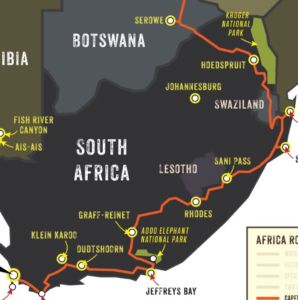The landlocked Kingdom of Lesotho (pronounced le-soo-too) is entirely surrounded by South Africa. Because the entire nation sits more than 1,400’ above sea level, it’s known as the Kingdom in the Sky. You’ll travel here on Renedian’s Cape Town to Victoria Falls: All Paved Route so here’s a snapshot to acquaint you with it.
 Government and Demographics
Government and Demographics
- Lesotho is a democratic, sovereign, and independent country and one of three remaining monarchies in Africa.
- Population is 2,285,392 (2018). Twenty-five percent live in urban areas with sixty percent between fifteen and sixty-four years of age. Animal herding and agriculture forms the main occupation for the remaining seventy-five percent of the population.
- Life expectancy is low: fifty-one years for men and fifty-six for women.
- Customary law and general law operate beside one another. Customary law descends from (indigenous) Basotho customs. General law originates from the Roman Dutch Law imported from South African. Basotho customs, originally all oral, but were written down in the early 1900s.
- Maseru, Lesotho’s capital and largest city (pop. 330,760 in 2016) lies directly on the Lesotho-South Africa border.
Geography and Climate
- Lesotho’s land area is 30,355 km2, slightly smaller than Maryland.
- The higher altitude creates a temperate climate with hot summers and cold winters. Maseru and its surrounding lowlands often reach 30°C/86°F in the summer. Winters can be cold. Lowlands get down to −7°C/19.4 °F and the highlands, where snow is common, can drop to −20°C/−4.0°F.
- Lesotho enjoys 300 days of sunshine every year. Rainy season extends between October and April.
Economy
- More than forty percent of the population lives below the poverty line. Many women in the country work due to the death of their husbands or their husband’s unemployment.
- Lesotho imports almost ninety percent of goods consumed from South Africa.
- The Lesotho Highlands Water Project (LHWP), Africa’s largest water transfer scheme, harnesses and commercializes her upstream surplus water sources. The project, which generates most of Lesotho’s hydroelectric power, provides Lesotho with income in exchange for providing water to South Africa’s Gauteng province where the majority of the country’s industrial and mining activities occur.
- The Basotho refer to water as “white gold” because of its abundance and commercial value.
Culture
- More than ninety-nine percent of the population identifies as Basotho, a Bantu-speaking people. Europeans and Chinese also live in the country.
- Sesotho, the national language became one of the first African languages to develop a written form. English is also an official language.
- Ninety percent of the people identify as Christian; forty-five percent Roman Catholic, twenty-six percent Evangelicals, Anglican, Latter Day Saints and other Christian groups. Muslims, Hindus, Buddhists, Baha’i, and indigenous religions make up the remaining ten percent.
- Traditional musical instruments include the lekolulo, a flute used in herding, setolo-tolo, and the stringed thomo.
- The traditional dwelling is the rondavel, a circular dwelling with a conical thatched roof.
- Traditional attire, the Basotho blanket, is a wool covering seen throughout the country during all seasons. Basotho blankets often contain colourful patterns and portray cultural identity as well as status.
- Radio ranks as the most popular form of media in the country.
- Pap-pap or papa, a cornmeal porridge (a dish consisting of oatmeal or another meal or cereal boiled in water or milk), forms the daily staple food. It’s accompanied with a thick sauce made from vegetables, peas, and other chopped greens.
Education
- Eight-five percent of the adult population is literate. Unlike most countries, Lesotho has a higher female literacy rate than male literacy rate. Less than four percent use the internet.
- Pre-school education starts with infants. Primary education, which starts at age six, leads to a five-year secondary school program and a mix of universities, technical and vocational colleges.
Flora and Fauna
- Sixty endemic species of mammals, 339 bird species, seventeen reptile species live here.
- Lesotho is also associated with Lesothosaurus (lizard from Lesotho), a dinosaur which evolved 200 million years ago in this region. It was one metre long, a herbivore, and bipedal.
- Lesotho is one of the least forested countries in Africa as its grassland ecosystem supports few tree species.
Lesotho Resources:

